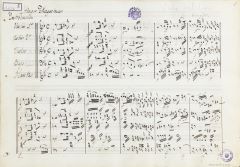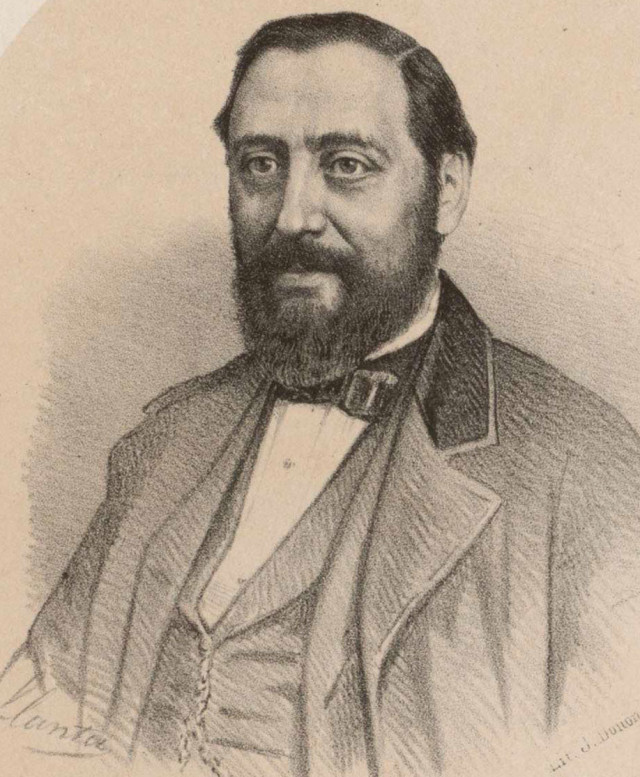‘The Seven Last Words of Christ’ by Haydn and Barbieri
Thursday, July 18, 2024

An ambitious digitization project targeting the musical heritage collections of the National Library of Spain has provided access to 31,000 musical sources that were long accessible only in the reading room, thereby inspiring both musicians and scholars to new discoveries. In the following we reprint from the library’s blog – with their kind permission – some thoughts by the musicologist Francisco Javier Orellana Vallejo regarding a manuscript acquired by the library in 1999 that includes Joseph Haydn’s The Seven Last Words (sign. MC/4634/3) as arranged by the composer Francisco Asenjo Barbieri.
The Seven Last Words of our Savior on the Cross is a widely known work whose origins are nonetheless practically unknown to the general public. Until recently it was believed that the work had been commissioned by the chapter of the Cathedral of Cádiz, but this has been disproved by Robert Stevenson and Marcelino Diez who, although unable to document the actual commission, have shown that it did not come from the Cathedral. Instead, the work was intended for the lower chapel of the oratory of the Santa Cueva in the same city. In this small subterranean chapel, meditations on the seven last words of Jesus Christ on the cross were celebrated every Good Friday morning. The liturgy consisted of the priest’s pronouncing the seven phrases, appending a brief sermon to each one, after which a sonata was played for the meditation of the believers who belonged to the brotherhood of the Old Mother, founded and formed predominantly by merchants and the bourgeoisie.
Haydn’s The Seven Last Words was commissioned to form part of a comprehensive project to ‘decorate’ the two chapels that make up the Santa Cueva oratory, initiated by the Marquis of Valde-Íñigo. For the upper chapel, the most splendid ornamentation was conceived in neoclassical style, including exquisite paintings by Francisco de Goya, while in the somber lower chapel the best possible music was meant to accompany the aforementioned meditations on the The Seven Last Words. The gloomy enough chapel was further covered with cloth to prevent the sunlight from entering, except for the skylight illuminating the sculptural group of the Calvary. No resources were spared for the commissioned composition, originally written for the typical orchestra of the period, namely a string ensemble and winds in pairs: 2 flutes, 2 oboes, 2 bassoons, 2 horns, 2 trumpets, and timpani. This first version (Hob. XX:1A - RISM Catalog | RISM Online) was published in 1787 and first performed in Vienna on 27 March 1787, likely performed in Cádiz the same year or even earlier.
The ‘Descendants’ of The Seven Last Words
The enormous popularity of The Seven Last Words is demonstrated by its ‘descendants’: a large number and variety of arrangements that came into circulation soon after its first publication. This proliferation proved especially intense after the 1801 publication of the oratorio version (Hob. XX:2 - RISM Catalog | RISM Online), which soon established itself in both the religious and the concert repertories. Therefore, a whole series of arrangements were produced at a very early date to adapt the work to diverse circumstances beyond its original liturgical function. The first such arrangement, for string quartet, was prepared by Haydn himself, followed by another one for harpsichord or fortepiano, both being completed in 1787.
The re-composition of The Seven Last Words by Francisco Asenjo Barbieri is based on the string quartet arrangement, since the version to be regularly performed in the Santa Cueva of Cádiz (since at least the middle of the 19th century) was this one and not the original orchestral version. We even know that, in order to increase the dramatic effect, the quartet played next to the Calvary sculpture, but hidden from the view of the believers. It was this version that Manuel de Falla also heard in his childhood.
It is worth pointing out that, even in this arrangement for string quartet alone, Haydn adapted the text of each ‘word’ to the instruments as if he was writing for voices. The first violin part of the first sonata provides a good example: the instrument unmistakably ‘sings’ the complete phrase of the first Word, as reflected also in the keyboard arrangement that reproduces the same adaptation to the text. Even though Haydn was commissioned to compose an instrumental work, he obviously kept very much in mind the supporting text, understood as a vehicle not only for the sacred words but also for the thoughts of each believer – an approach that testifies for his individual if bourgeois concept of spirituality.
The Version by Francisco Asenjo Barbieri (1840)

Francisco Asenjo Barbieri
It was in 2017, while doing research at the University of La Rioja on the numerous ‘descendants’ of Haydn’s The Seven Last Words, that I came across Francisco Asenjo Barbieri’s version, which I was able to find thanks to the commendable digitization efforts of the National Library of Spain. It is a full score in manuscript dated 29 September 1840, and (as mentioned above) is based on the arrangement for string quartet (Hob. XX:1B).
Francisco Asenjo Barbieri (1823-1894) was a versatile personality of Spanish musical romanticism. A celebrated composer of zarzuela, he was also active as musicologist, conductor, and collector. His abundant bibliographic and musical legacy can today be consulted in the national library in Madrid. Emilio Casares, the undoubtedly greatest Barbieri scholar, described him as “the fundamental figure of Spanish musical romanticism”. Barbieri copied, studied, conducted Haydn’s works, and viewed him as a composer of reference. His passion for both Haydn and collecting is amply demonstrated by an 1889 letter by Antonio Barberán y Pacheco, in which he offers Barbieri a copy of the original orchestral version of The Seven Last Words in Haydn’s hand. Unfortunately, we do not know anything of the whereabouts of this source or of its authenticity.
Barbieri was 17 years of age when he signed the full score – a mere three years after beginning his musical studies with Baltasar Saldoni, and soon after starting his composition studies with Ramón Carnicer, whom he considered his teacher throughout his life.
The most striking feature of Barbieri’s version is the addition of a flute part to the quartet arrangement, and equally striking is the fact that this fifth voice (notated on the bottommost staff) complements Haydn’s original with entirely different, new melodic material from the very first bars. As a rule, the flute fills the rests, thus engaging in a ‘dialog’ with Haydn’s music. Indeed, Barbieri’s contribution is so individual that it goes its own way even in those passages of the orchestral version where the flute obtains special relevance, as in Sonata III (whereby it should be remembered that the starting point for Barbieri was the arrangement for string quartet).
While the flute doubles the first violin in several passages, not for a moment can we have a doubt about Barbieri’s absolute respect for the original, since he does not alter a single note by Haydn. In certain passages, for instance in Sonata IV, some instruments acquire special relevance, and here Barbieri skillfully makes the flute converse with them, at the same time avoiding to overshadow these solo passages by deftly silencing the wind instrument afterwards.
One could cite many other examples of the young Barbieri’s mastery, but his creativity arguably proves the most striking at the beginning of Sonata V, where he takes advantage of the pizzicato walking melody of the quartet to allow the flute to sing freely. This is the only one of the seven sonatas without vocal correspondence (that is, where no text was added to the music); a fact that becomes evident in the oratorio version, which at this point lacks an incipit to be sung by the choir.
Overall, Barbieri’s version is exceptional in its being the only arrangement known to us that presents completely new melodic material simultaneously with the original, instead of reworking the preexisting motifs or traditionally using the flute as a substitute for the first violin. One could view it as a work for concert performance, as one to be played in a religious context, or simply as a composition exercise – the latter being the most plausible option, given Barbieri’s age and personal situation at the time of writing.
Image (above): Full Score of The Seven Words by Joseph Haydn in the arrangement of Francisco Asenjo Barbieri. (E-Mn MC/4634/3)
Share Tweet EmailCatégorie: Collections de bibliothèques

